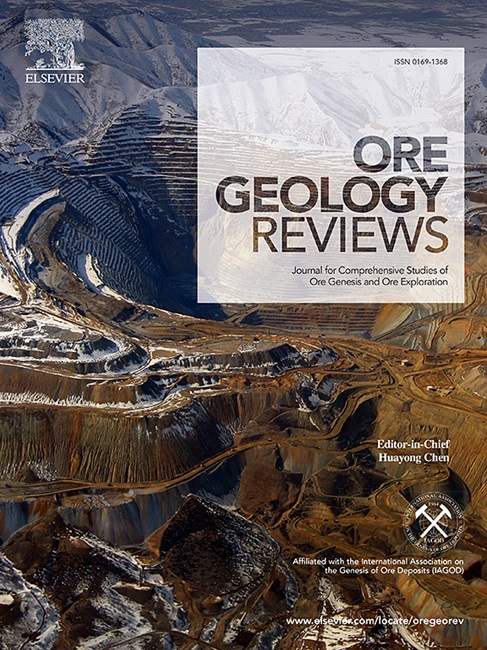胶东金青顶金矿粗粒黄铁矿地球化学、同位素及形态特征:幕式成矿流体演化意义
IF 3.6
2区 地球科学
Q1 GEOLOGY
引用次数: 0
摘要
金青顶金矿床是胶东金省代表性矿体,含丰富的粗粒黄铁矿,其形态多样,有立方体(a)、八面体(o)、四方三面体(m)、五边形十二面体(e)、组合形态(e + a)等。黄铁矿具有明显的形态演化特征,岩心以Pya/Pyo为主,地幔以Pyo/Pym为主,岩缘以Pye和Pye + a为主。i/j =形态编码)和包裹体和孔隙较差的黄铁矿(Pyi)。综合形态演化、微观结构表征、原位元素和硫同位素分析阐明了微观尺度上的成矿过程。形态演化表明了从高温到中温的冷却轨迹,并伴随着硫过饱和度的增加。微量元素(Au、Ag、Te、Bi)富集于Pyi-j中,并在“断阀”压降过程中由黄铁矿快速结晶和流体不混溶形成。金主要以固溶体(Au+)的形式存在,富集过程受Te和Bi而不是As控制。硫同位素(δ34S: 7.8 ~ 22.2‰)在“断阀”过程中受氧化作用(主驱动)、瑞利分馏作用和冷却作用的影响,呈现出从核到环的递减趋势。研究表明,“断阀”作用控制了流体的幕式压降,促进了黄铁矿的结晶和金属的沉积。这些发现提供了流体演化的微观记录,并强调了氧化、温度和硫动力学在金矿化中的关键作用。本文章由计算机程序翻译,如有差异,请以英文原文为准。

Geochemistry, isotopes, and morphology of coarse-grained pyrite from the Jinqingding gold deposit, Jiaodong Peninsula: Implications for episodic ore-forming fluid evolution
The Jinqingding gold deposit, a representative orebody in the Jiaodong gold province, hosts abundant coarse-grained pyrites that exhibit diverse morphologies, including cube (a), octahedron (o), tetragonal trisoctahedron (m), pentagonal dodecahedron (e), and combined forms (e.g., e + a). These pyrites display distinct morphological evolution with cores dominated by Pya/Pyo, mantles of Pyo/Pym, and rims dominated by Pye and Pye + a. Microstructurally, two pyrite types are identified: inclusion- and pore-rich pyrite (Pyi-j; i/j = morphology codes) and inclusion- and pore-poor pyrite (Pyi). Integrated morphological evolution, microstructural characterization, in-situ elements, and sulfur isotope analyses elucidate mineralization processes at the microscale.
Morphological evolution indicates a cooling trajectory from high to intermediate temperatures, coupled with increasing sulfur supersaturation. Trace elements (e.g., Au, Ag, Te, and Bi) are enriched in Pyi-j and formed by rapid pyrite crystallization and fluid immiscibility during pressure drops triggered by the “fault-valve” process. Gold primarily exists in the form of a solid solution (Au+), with enrichment processes that are controlled by Te and Bi rather than As. Sulfur isotopes (δ34S: 7.8–22.2 ‰) display a core-to-rim decrease that is driven by oxidation (primary driver), Rayleigh fractionation and cooling during the “fault-valve” process. This study establishes that the “fault-valve” process governed episodic fluid pressure drops, promoting pyrite crystallization and metal deposition. The findings provide a microscale record of fluid evolution and highlight the critical roles of oxidation, temperature, and sulfur dynamics in gold mineralization.
求助全文
通过发布文献求助,成功后即可免费获取论文全文。
去求助
来源期刊

Ore Geology Reviews
地学-地质学
CiteScore
6.50
自引率
27.30%
发文量
546
审稿时长
22.9 weeks
期刊介绍:
Ore Geology Reviews aims to familiarize all earth scientists with recent advances in a number of interconnected disciplines related to the study of, and search for, ore deposits. The reviews range from brief to longer contributions, but the journal preferentially publishes manuscripts that fill the niche between the commonly shorter journal articles and the comprehensive book coverages, and thus has a special appeal to many authors and readers.
 求助内容:
求助内容: 应助结果提醒方式:
应助结果提醒方式:


